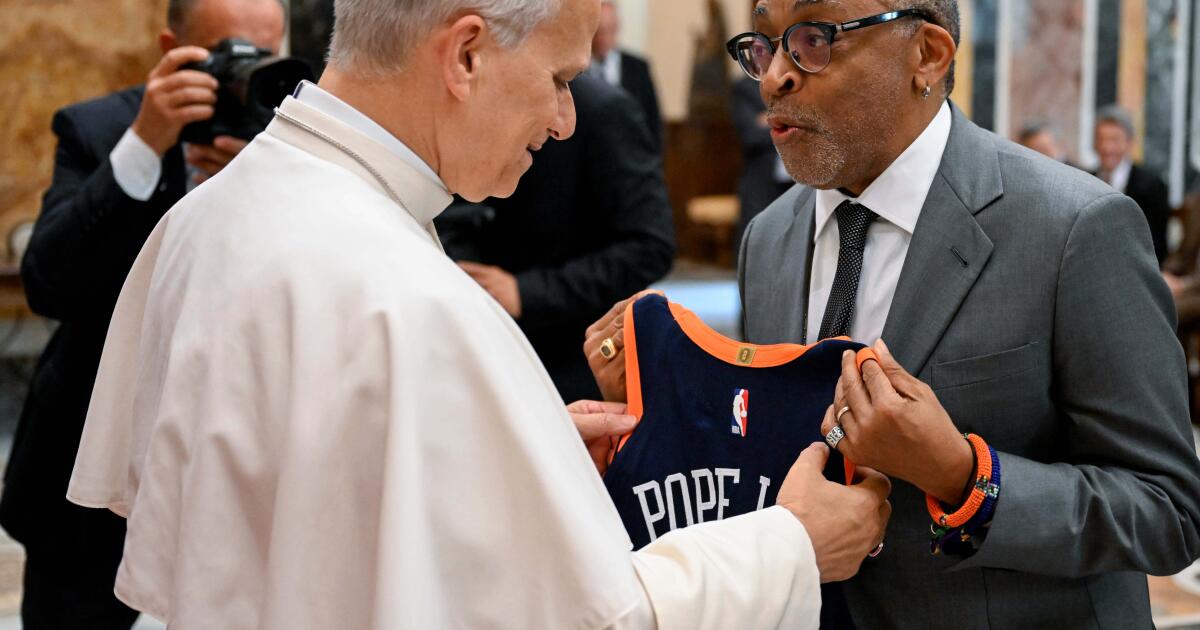VATICAN CITY — Pope Leo XIV welcomed Spike Lee, Cate Blanchett, Greta Gerwig and dozens of other Hollywood luminaries to a special Vatican audience Saturday celebrating cinema and its ability to inspire and unite.
Leo encouraged the filmmakers and celebrities gathered in a frescoed Vatican audience hall to use their art to include marginal voices, calling film “a popular art in the noblest sense, intended for and accessible to all.”
“When cinema is authentic, it does not merely console, but challenges,” he told the stars. “It articulates the questions that dwell within us, and sometimes, even provokes tears that we didn’t know we needed to shed.”
The encounter, organized by the Vatican’s culture ministry, followed similar audiences Pope Francis had in recent years with famous artists and comedians. It’s part of the Vatican’s efforts to reach out beyond the Roman Catholic Church to engage with the secular world.
But the gathering also seemed to have particular meaning for history’s first American pope, who grew up in the heyday of Hollywood. The 70-year-old, Chicago-born Leo just this week identified his four favorite films: “It’s a Wonderful Life,” “The Sound of Music,” “Ordinary People” and “Life Is Beautiful.”
In a sign of how seemingly star-struck he was, Leo spent nearly an hour after the audience greeting and chatting amiably with each of the participants, something he rarely does for large audiences.
Drawing applause from the celebrities, Leo acknowledged that the film industry and cinemas around the world were experiencing a decline, with theaters that had once been important social and cultural meeting points disappearing from neighborhoods.
“I urge institutions not to give up, but to cooperate in affirming the social and cultural value” of movie theaters, he said.
Celebrities just happy to be invited
Many celebrities said they found Leo’s words inspiring, and expressed awe as they walked through the halls of the Vatican‘s Apostolic Palace, where a light luncheon reception awaited them after the audience.
“It was a surprise to me that I even got invited,” Lee told reporters along the red carpet in the palace.
During the audience, Lee had presented Leo with a jersey from his beloved Knicks basketball team, featuring the number 14 and Leo’s name on the back. Leo is a known Chicago Bulls fan, but Lee said he told the pope that the Knicks now boast three players from the pope’s alma mater, Villanova University.
Blanchett, for her part, said the pope’s comments were inspiring because he understood the crucial role cinema can play in transcending borders and exploring sometimes difficult subjects in ways that aren’t divisive.
“Filmmaking is about entertainment, but it’s about including voices that are often marginalized, and not [shying] away from the pain and complexity that we’re all living through right now,” she said.
She said Leo, in his comments about the experience of watching a film in a dark theater, clearly understood the culturally important role cinemas can play.
“Sitting in the dark with strangers is a way in which we can reconnect to what unites us rather than what divides us,” she said.
A ‘hit and miss’ guest list that grew
The gathering drew a diverse group of filmmakers and actors, including many from Italy, like Monica Bellucci and Alba Rohrwacher. American actors included Chris O’Donnell, Judd Apatow and Leslie Mann, Apatow’s wife.
Director Sally Potter said she was impressed that Leo took the time to speak with each one of them. And she said she loved his comments about the value of silence and slowness in film.
“It was a good model of how to be and how to think about cinema,” she said, noting especially Leo’s defense of “slow cinema” and not seeing the moving image just in terms of algorithms.
Director Gus Van Sant said he liked Leo’s vibe.
“He was very laid-back, you know, he had a fantastic message of beauty in cinema,” he said.
Archbishop Paul Tighe, the No. 2 in the Vatican culture ministry, said the guest list was pulled together just in the last three months, with the help of the handful of contacts Vatican officials had in Hollywood, including director Martin Scorsese.
The biggest hurdle, Tighe said, was convincing Hollywood agents that the invitation to come meet Leo wasn’t a hoax. In the end, as word spread, some figures approached the Vatican and asked to be invited.
“It’s an industry where people have their commitments months in advance and years in advance, so obviously it was a little hit and miss, but we’re very pleased and very proud” by the turnout, he said.
The aim of the encounter, Tighe said, was to encourage an ongoing conversation with the world of culture, of which film is a fundamental part.
“It’s a very democratic art form,” Tighe said. Saturday’s audience, he said, was “the celebration of an art form that I think is touching the lives of so many people and therefore recognizing it and giving it its true importance.”
Winfield writes for the Associated Press. AP journalists Trisha Thomas and Isaia Montelione contributed to this report.

